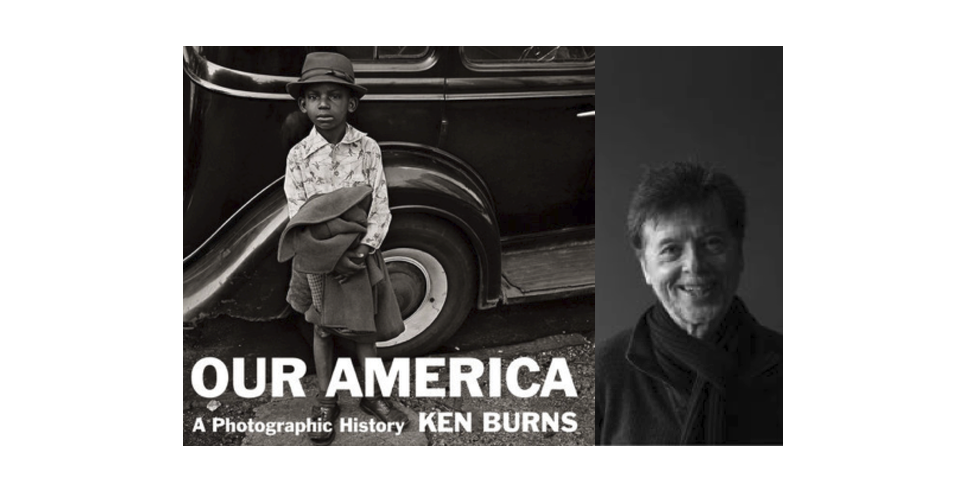
Renowned American visual historian and documentary filmmaker Ken Burns’s love affair with photography began when he was a toddler, as he describes in his powerful and arresting new book, Our America: A Photographic History (Knopf). As a young child, he watched his father, a professor of cultural anthropology, perform magic in a darkroom by simply dousing blank photographic papers in pans of chemicals and then revealing the slow emergence of stunning images.
The engaging and often moving photographs in Our America are the product of years of Mr. Burns’s extensive research and meticulous curation from tens of thousands of images. The book reflects the same qualities that characterize his award-winning documentaries: painstaking attention to detail and historical accuracy. And still photographs are the building blocks for his films.
The book presents 251 black and white photographs in chronological order that span our history from 1839 (with the first known American selfie) to 2019 (with a striking portrait of civil rights icon and Congressman John Lewis). The photos appear one per page and are captioned with only the location shown and the year of the image. At the back of the book, a section of “Illustration Notes” offers information on provenance and the historical context of each photo, often revealing facts that deepen the mystery of our past or heighten the contradictory nature and wonder of our history. The book tracks themes that are familiar to viewers of Burns’s films—from race and conflict and brutality to moments of innovation and genius and justice.
With this powerful collection of images, Mr. Burns captures our democratic spirit and our at times confounding past. He writes of the book: “Here is our authenticity, our sacrifice, our playfulness, our curiosity, and our grief. Here is our beauty, fragility, grandeur, and cool. Here is reflection and perseverance, industry and nature. Our harmony and our dissonance. Our forgetfulness and our memory.”
Our America can be viewed as a visual poem and, as with great poetry, each reading is likely to inspire new insights and revelations. It can be seen as a kaleidoscope of frozen moments in time.
A few of the images may be well known to some readers, but most are rare and often deeply personal. The book includes work by legendary photographers from Mathew Brady and Alexander Gardner from the Civil War era to Lewis Hine and Ben Shahn and Dorothea Lange in the early 20th century, to more recent photos from the likes of Sally Mann and Keith Dotson and Michael Avedon, but in many cases the photographers are unknown.
The juxtaposition of photos on facing pages is intentional and certain to arouse varying interpretations and musings from readers who read and reread the book. For example: A photograph of the 1861 inauguration of Confederate President Jefferson Davis faces an interior shot of Fort Sumter from the same year. An 1890 portrait of an aging Chief Red Cloud of the Oglala Lakota nation is juxtaposed with a photo made in the 1890s of a tourist summer colony in Maine. A 1914 photograph of very young children working at machines in a hosiery mill in North Carolina faces a 1914 portrait of renowned American poet Edna St. Vincent Millay in a bucolic setting in New York State. A gripping photograph of the Japanese bombing of the U.S. fleet at Pearl Harbor faces a 1942 photograph of Japanese Americans lined up for state-sponsored relocation and incarceration at American concentration camps.
Our America is an unsanitized journey and a vital document now as forces in the country challenge the dream of equality for all and the very foundations of our democracy. Contrary to those who seek to erase our past and divide our citizenry, Mr. Burns shares in his book a history of “us,” through times of despair and horror and times of healing and triumph, with moments of justice and grace and hope. As he writes, “there is only ‘us.’ No ‘them.”
The images that Mr. Burns chose from “our” past also have a special resonance and timeliness now. In her prologue to the book, Susan Hermanson Meister—Executive Director of the Aperture Foundation and a former photography curator at the Museum of Modern Art, New York—describes Mr. Burns’s book of photographic history as follows: “Our America is an intentionally idiosyncratic, deeply personal collection of photographs that have shaped our understanding of ourselves and our history. It is, too, a powerful monument to our moment.”
Ken Burns has been making acclaimed documentary films for over forty years. Since his Academy Award nominated Brooklyn Bridge in 1981, he has directed and produced some of the most renowned historical documentaries ever, including, The Civil War; Baseball; Jazz; The War; The National Parks: America’s Best Idea; The Roosevelts: An Intimate History; Jackie Robinson; The Vietnam War; Country Music; Benjamin Franklin; Hemingway; and The U.S. and the Holocaust. His films have been honored with dozens of major awards, including 16 Emmy Awards, two Grammy Awards, and two Oscar nominations. And, in September 2008, at the News and Documentary Emmy Awards, Mr. Burns received a Lifetime Achievement Award from the Academy of Television Arts & Sciences.
Mr. Burns graciously responded by telephone from his New Hampshire studio to questions about his career and his new photographic history of America. Here is the link to the entire interview that was Published in the History News Network Dec 19 2022.








